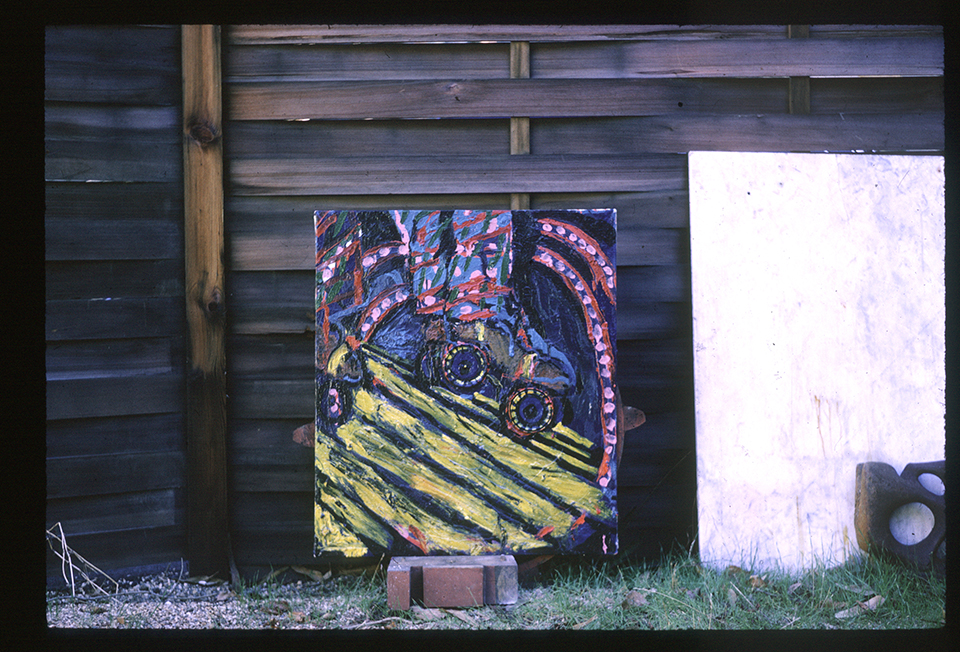From the Archive: The Early Work of Elizabeth Murray (Mills College '62-'64)
Elizabeth Murray, “View of S. F. (San Francisco),” 1963, Oil on canvas and wood, 51 x 36 in. (129.5 x 91.4 cm) Current location unknown
In a series of new blog posts, Jason Andrew shares new research into the early work of Elizabeth Murray. The first of three such research posts highlights Murray’s graduate school days at Mills College (1962-64).
In 1962, Elizabeth Murray left Chicago for graduate school at Mills College. “It wasn’t like being in school,” she said of her time at Mills, “Nobody bothered me and it was two years to work. Rather than being scared that I couldn’t do it, I felt I could, that I was an artist. ”[1] But what kind of work did she make? With the discovery of a small group of slides in the artist’s upstate studio… now we know.
“View of S. F. (San Francisco” was painted in the fall of 1963 and features a composition of a painting within a painting—a device she likely borrowed from Jasper Johns, whose retrospective she saw in 1962 when it traveled from the Everett Ellin Gallery, Los Angeles to the Richmond Art Center, Richmond, CA.
“I was very affected by the show of Johns, it was just fantastic. Watching someone use paint in such a structured kind of way and yet with that kind of humor and that kind of seriousness all combined. It all felt very pertinent to me and very psychological also.”
Elizabeth Murray, “Heads and Rainbow,” 1963, Oil on canvas, 48 x 36 in. (121.9 x 91.4 cm) Current location unknown
At Mills, Ralph DuCasse was the head of the graduate department. “he was the only [teacher] I had,” Murray recalls, “And he was great. He just left me alone.”[2]
Her time at Mills was an informative and experimental time. She learned a lot from being out West because as she puts it, “the environment is so incredible.”[3]
“I spent three years there [Mills] going to graduate school. I was so serious about my work that I wouldn’t talk to anybody at all, I just worked and did a lot of reading: Einstein and things like that to find out about physics, science, and philosophy; James Joyce novels; I think I was using up the intellectual part of myself, really getting rid of my mind […] I started to do these enormous twenty-foot paintings, which was really good for me.”[4]
“[…] there were some interesting people around there at that time. San Francisco was sort of having a renaissance. Everyone was excited about art and people there like [William] Wiley, [Frank] Lobdell, the California figure painters, were hitting their prime. And this guy Carlos Villa was someone I went to school with. He influenced me enormously. The thing that was good was there wasn’t this kind of high seriousness. Like ‘I’ll die doing it, it’s too much.’ They drank beer while they worked, and they did this and that. It was a good experience—it broke me open a little bit.”
Elizabeth Murray, “Figure Roller Skating,” 1963, Oil on tin cans and canvas, 48 x 36 in. (121.9 x 91.4 cm) Current location unknown
When asked to describe the work she made at Mills College, Murray explained, “Big drippy paintings with surface kinds of forms. I was influenced by Gorky and de Kooning. It was real unconscious work. Very physical work. I was going up to the canvas and smushing the paint on and throwing it on. It was my whole life.”[5]
Later, at the time of her inclusion in the exhibition Early Work by Fine Contemporary Artists: Ron Gorchov, Elizabeth Murray, Dennis Oppenheim, Dorothea Rockburne, Joel Shapiro at the The New Museum, Murray would tell Allan Schwartzman:
“The clear connect [with the early work] to me would be the paint, which I’m very involved in. And I see real connections in the way I feel about the paint, the way I manipulate the paint and use the paint from one painting to another. And the other connection is the move into deeper use of shapes. I see how I’ve used the same shape again and again in different ways. Also the work has become more open to color.”[6]
[1] Horsfield, Kate and Lyn Blumenthal. Profile. Vol. 5, Elizabeth Murray. Chicago: Video Data Bank of the School of the Art Institute of Chicago, Summer 1986. Published transcript, p. 6.
[2] McCarron, John. “interview with Elizabeth Murray.” Shift 5 (San Francisco) Vol 3, No 1 (1989), p. 16, Published quarterly by San Francisco Artspace.
[3] McCarron, John. “interview with Elizabeth Murray.” Shift 5 (San Francisco) Vol 3, No 1 (1989), p. 16, Published quarterly by San Francisco Artspace.
[4] Interview with Elizabeth Murray: Early Work by Fine Contemporary Artists: Ron Gorchov, Elizabeth Murray, Dennis Oppenheim, Dorothea Rockburne, Joel Shapiro at the The New Museum, exhibition catalogue, n.p.
[5] Horsfield, Kate and Lyn Blumenthal. Profile. Vol. 5, Elizabeth Murray. Chicago: Video Data Bank of the School of the Art Institute of Chicago, Summer 1986. Published transcript, p. 7.
[6] Interview with Elizabeth Murray: Early Work by Fine Contemporary Artists: Ron Gorchov, Elizabeth Murray, Dennis Oppenheim, Dorothea Rockburne, Joel Shapiro at the The New Museum, exhibition catalogue, n.p.
Elizabeth Murray, Untitled, 1962, Oil on canvas, 60 x 78 in. (152. 4 x 198.1 cm) Current location unknown



